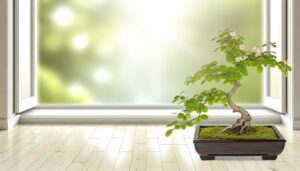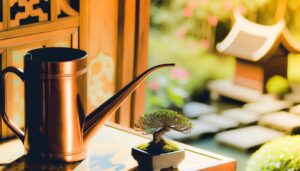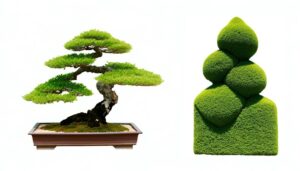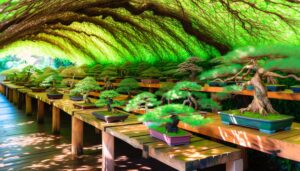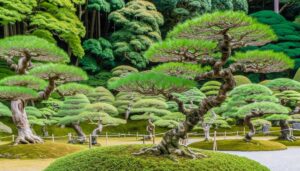Do Bonsai Like Full Sun?
Bonsai trees such as Juniperus, Pinus, and Acer palmatum typically thrive in full sun, benefiting from at least six hours of direct sunlight daily to optimize photosynthesis and growth. These conditions foster compact foliage, strong needle growth, and vibrant coloration.
However, overexposure to intense sunlight can cause leaf burn and dehydration, necessitating gradual acclimation and possibly the use of shade cloth during peak hours. Conversely, species like Ficus retusa and Chinese Elm flourish in partial shade, adapting well to lower light levels.
Monitoring sunlight intensity and seasonal light variations is essential for maintaining bonsai health. Insightful details on species-specific needs follow.
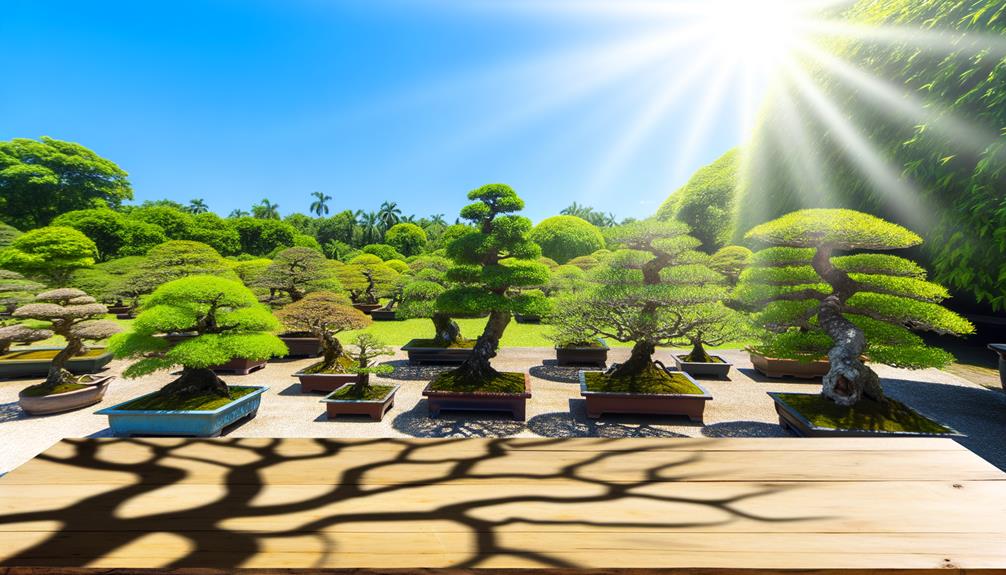
Key Takeaways
- Juniperus, Pinus, and Acer palmatum thrive in full sunlight.
- Junipers need at least six hours of sun daily for compact growth.
- Pines show strong needle growth and trunk thickening in full sun.
- Japanese Maples develop best under morning or late afternoon sunlight.
- Excessive sunlight can cause leaf burn and dehydration.
Understanding Bonsai Light Needs
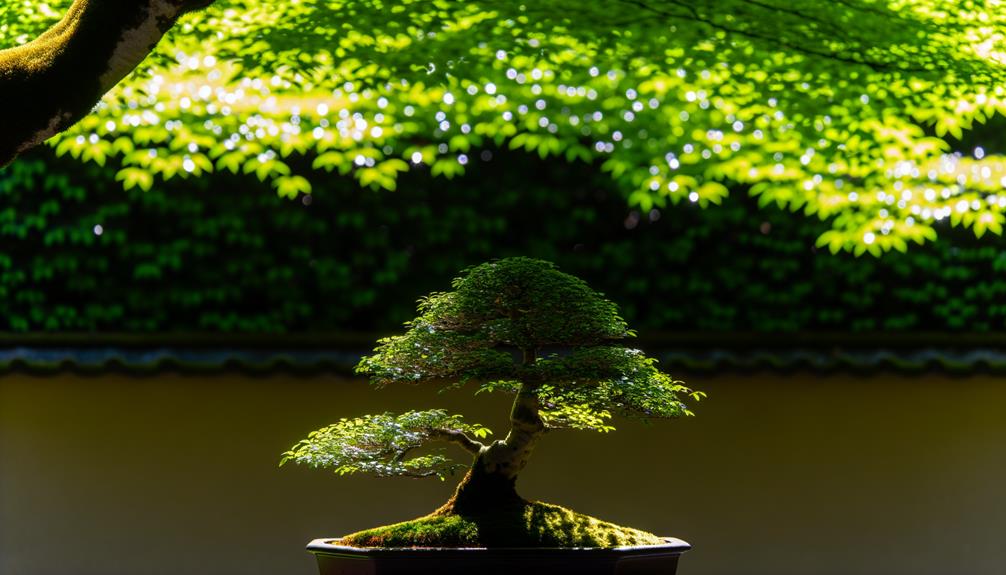
Understanding the light needs of bonsai trees is crucial for their growth and development, as light intensity and duration directly impact photosynthesis and overall plant health. Adequate light guarantees that chlorophyll, the pigment responsible for photosynthesis, can perform at its best. Insufficient light can result in weakened growth, elongated stems, and reduced foliage density.
Conversely, excessive light, especially intense direct sunlight, may lead to leaf burn or dehydration. Monitoring light levels using a light meter can provide accurate data to adjust positioning. In practical terms, placing bonsai trees near south-facing windows or using grow lights with timers can replicate ideal light conditions. Regularly rotating the bonsai ensures uniform light exposure, promoting consistent growth and vibrant foliage.
Sun-Loving Bonsai Species
Several bonsai species thrive in full sunlight, displaying optimal growth and vibrant foliage when exposed to abundant direct light.
Significantly, species such as the Juniperus (Juniper), Pinus (Pine), and Acer palmatum (Japanese Maple) exhibit exceptional resilience and vigor under extensive sun exposure.
Junipers, with their needle-like leaves, require at least six hours of sun daily to maintain their compact structure and vibrant green hue.
Pines, particularly well-suited for outdoor placement, show strong needle growth and enhanced trunk thickening in full sun.
Japanese Maples, while requiring some protection from intense midday sun in hotter climates, develop their characteristic leaf coloration and fine branching structure best under morning or late afternoon sunlight.
Sufficient sun exposure is vital for their photosynthetic efficiency and overall health.
Shade-Tolerant Bonsai Types
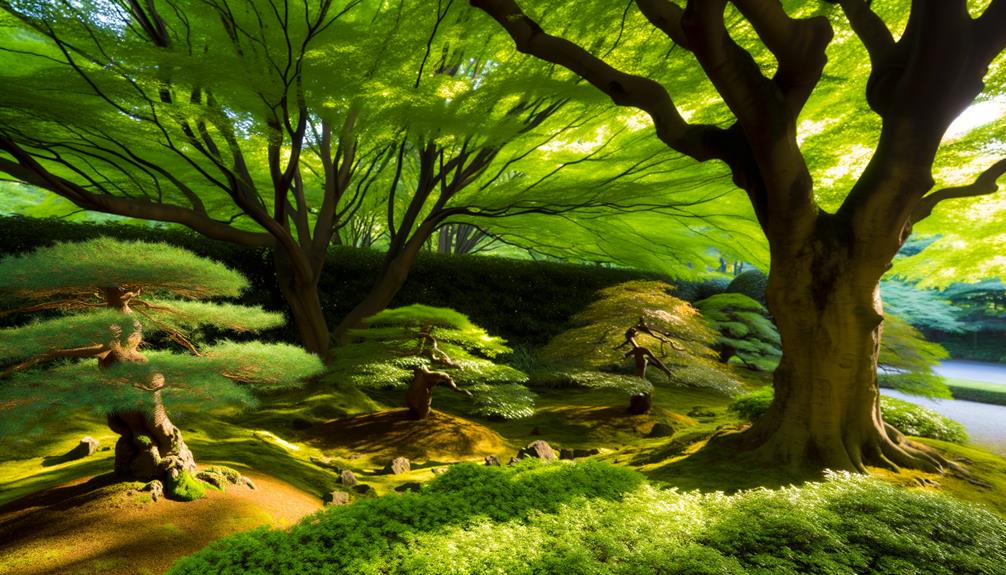
Certain bonsai varieties excel in low-light environments, demonstrating remarkable adaptability and sustained vigor even with limited sun exposure. These species possess inherent physiological traits enabling efficient photosynthesis in shaded conditions.
For bonsai enthusiasts with shaded patios or indoor setups, selecting shade-tolerant varieties ensures optimal plant health and growth.
Consider the following shade-tolerant bonsai types:
- Ficus (Ficus retusa): Known for its robust structure, Ficus thrives indoors with indirect sunlight, requiring minimal direct light.
- Chinese Elm (Ulmus parvifolia): Exhibits flexibility in light conditions, maintaining lush foliage in partial shade.
- Japanese Maple (Acer palmatum): Prefers dappled sunlight, avoiding direct exposure to prevent leaf scorch.
Understanding these species' specific light requirements enhances their aesthetic and durability in less sunny environments.
Seasonal Light Requirements
Understanding the seasonal light requirements of bonsai is critical for their best growth and health.
During summer, bonsai trees benefit from increased sun exposure, which enhances photosynthesis and vigor.
In contrast, winter demands a more nuanced approach, often necessitating supplemental lighting or strategic placement to guarantee sufficient light without overexposure to cold temperatures.
Summer Sun Exposure
During the summer months, bonsai trees need a significant amount of direct sunlight to optimize their photosynthetic processes and promote robust growth. Adequate summer sun exposure is vital, as it facilitates the synthesis of chlorophyll and enhances cellular respiration.
However, it is equally important to monitor the intensity and duration of sunlight to prevent photoinhibition and leaf scorch.
Consider the following practical advice:
- Gradual Acclimatization: Ease bonsai trees into full sun gradually to mitigate stress.
- Shade Regulation: Use shade cloths during peak midday hours to prevent excessive heat accumulation.
- Water Management: Increase watering frequency to compensate for accelerated evapotranspiration rates.
Winter Light Needs
Securing adequate light exposure during the winter months is crucial for maintaining the physiological health of bonsai trees, as reduced daylight and lower solar angles can greatly impact their photosynthetic capability.
Deciduous and evergreen bonsai species exhibit varying light requirements; however, both benefit from supplemental lighting during shorter days. Utilization of full-spectrum grow lights, positioned to mimic natural sunlight, can mitigate the adverse effects of insufficient natural light.
It's advisable to provide 12-16 hours of artificial light daily to maintain best growth and metabolic functions. Additionally, rotating the bonsai to ensure even light distribution can prevent phototropic imbalances.
Monitoring light intensity with a lux meter can offer quantitative insights, enabling precise adjustments for optimal plant health.
Signs of Light Stress
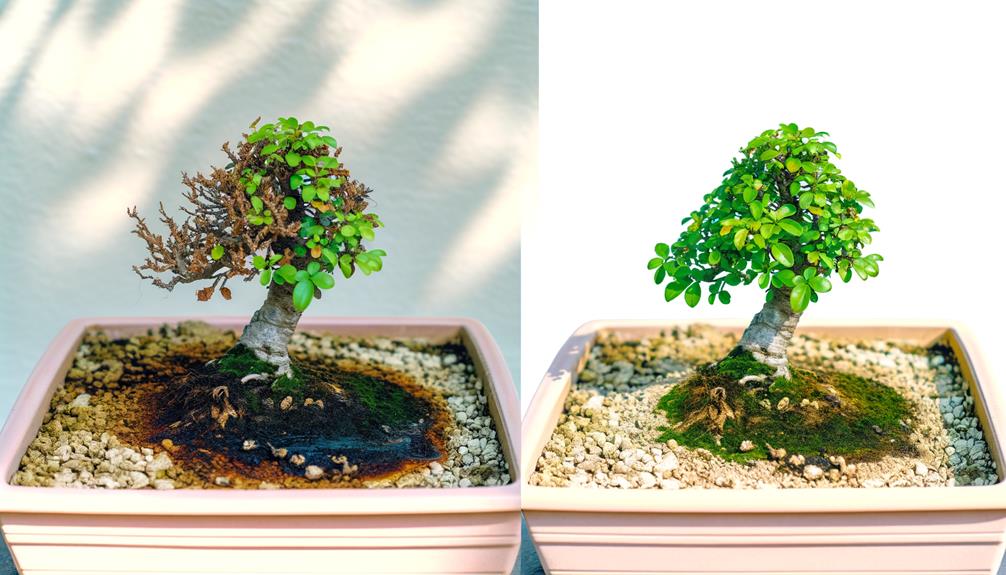
Light stress in bonsai is often indicated by leaf discoloration, where leaves may turn yellow or exhibit burnt edges due to excessive sunlight.
Additionally, wilting and drooping of leaves are critical signs that the plant is unable to retain adequate moisture under intense light conditions.
Monitoring these symptoms can help in adjusting light exposure to maintain the health and aesthetics of your bonsai.
Leaf Discoloration
Observing leaf discoloration is vital for diagnosing light stress in bonsai trees. Light stress manifests in several distinctive ways, often signified by changes in leaf pigmentation. For the attentive grower, these signs are crucial for timely intervention and care adjustments.
- Chlorosis: Yellowing of leaves due to insufficient chlorophyll production, indicating overexposure to direct sunlight.
- Scorching: Brown, crispy leaf edges that result from excessive light intensity causing cellular damage.
- Anthocyanin Accumulation: Red or purple hues appearing on leaves, a defense mechanism against UV radiation.
These symptoms require practical measures such as adjusting the bonsai's location or using shade cloths to mitigate light intensity. Regular monitoring and environmental adjustments can prevent irreversible damage and guarantee healthy growth.
Wilting and Drooping
In addition to leaf discoloration, wilting, and drooping are prominent indicators of light stress in bonsai trees. This stress often results from prolonged exposure to intense sunlight. Wilting occurs when the tree's ability to uptake water is compromised, leading to a loss of turgor pressure within the cells. This physiological stress manifests as drooping branches and leaves.
Detailed observations reveal that these symptoms are particularly pronounced during midday when solar radiation is at its peak. To mitigate light stress, it is advisable to provide partial shade during the hottest parts of the day. Utilizing shade cloths or relocating bonsai to a less exposed position can effectively reduce the risk.
Monitoring soil moisture levels and ensuring adequate hydration can further alleviate these stress conditions.
Optimizing Light Exposure
To optimize light exposure for bonsai trees, it is crucial to understand the specific light requirements of each species. Their photosynthetic efficiency directly impacts growth and health. Different species exhibit varying tolerances to light intensity, photoperiod, and spectral quality.
- Light Intensity: Evaluate the natural habitat of the species to determine if full sun or partial shade is ideal.
- Photoperiod: Acknowledge seasonal changes in daylight duration and adjust placement accordingly to mimic natural conditions.
- Spectral Quality: Use grow lights that replicate the spectrum of natural sunlight if natural light is insufficient.
Implementing these strategies ensures the bonsai receives optimal light exposure, promoting robust growth and reducing stress-related symptoms.
Proper light management is vital for maintaining the overall health of bonsai trees.
Indoor Vs. Outdoor Bonsai Light
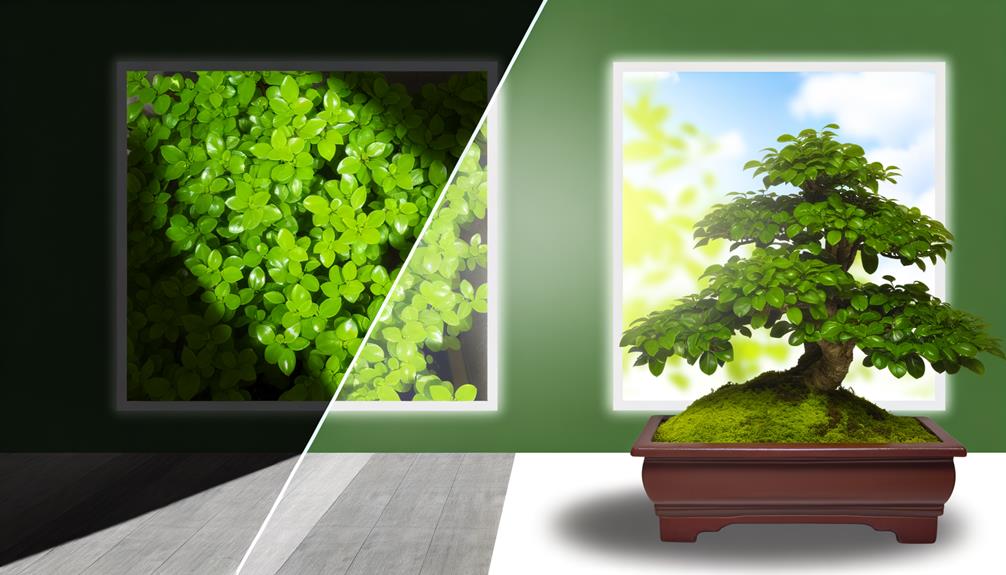
Understanding the differences in light requirements for indoor versus outdoor bonsai is essential for promoting ideal growth and health of the trees.
Outdoor bonsai, such as Juniper and Pine, thrive in full sun, needing at least six hours of direct sunlight daily. Observationally, outdoor bonsai exhibit robust growth patterns and foliage density under ample sunlight. Practical advice includes rotating indoor bonsai weekly to promote even light distribution and avoiding drafty or excessively shaded locations.
In contrast, indoor bonsai, like Ficus and Jade, require bright, indirect light, mimicking their natural, shaded habitats. For outdoor bonsai, placement in a south-facing area optimizes sun exposure.
Adhering to these specific light needs supports healthier and more vibrant bonsai specimens.
Artificial Lighting Solutions
Although natural sunlight is ideal, artificial lighting solutions provide a viable alternative for maintaining the health of bonsai trees, especially when natural light is insufficient. High-quality artificial lights can mimic the full spectrum of sunlight, thereby facilitating photosynthesis and promoting robust growth.
Key artificial lighting options include:
- LED Grow Lights: Energy-efficient and customizable, offering specific light spectrums.
- Fluorescent Lights: Suitable for small, indoor setups, providing broad-spectrum light.
- High-Intensity Discharge (HID) Lights: Powerful and effective, ideal for larger bonsai collections.
When selecting artificial lights, consider factors such as light intensity, duration, and spectrum. Proper placement and periodic adjustment are essential to ensure that the bonsai receives uniform light exposure, thereby simulating the benefits of natural sunlight.
Regional Light Considerations
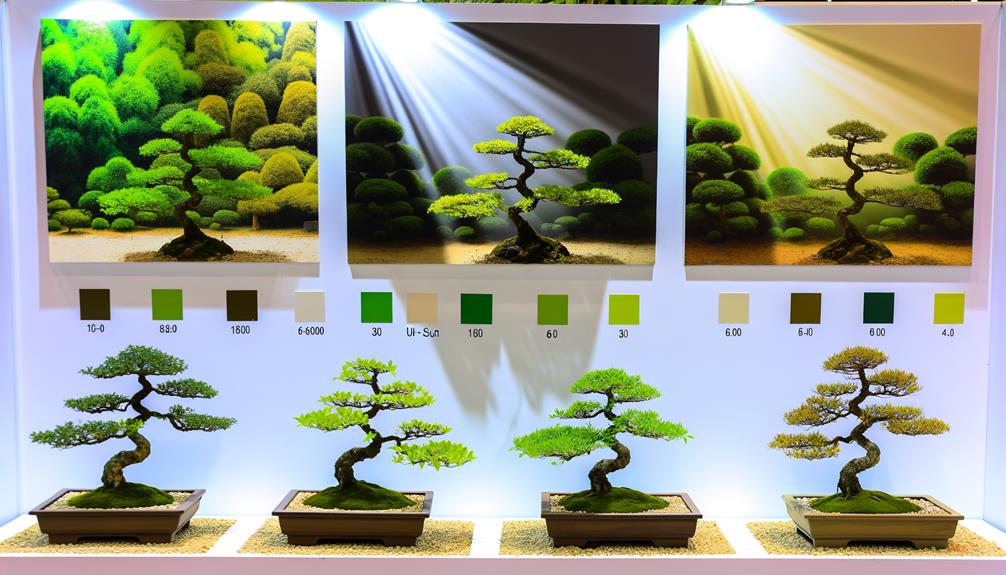
When cultivating bonsai trees, regional light variations have a major impact on their growth and health, requiring customized strategies for the best sunlight exposure.
In temperate zones, bonsai often thrive in full sun, benefiting from the direct light to sustain photosynthesis and vigorous growth.
Conversely, in equatorial regions with intense solar radiation, partial shade may be necessary to prevent leaf scorch and dehydration.
In higher latitudes, where daylight hours shorten significantly in winter, supplemental artificial lighting becomes essential to maintain photoperiodic balance.
Observing microclimates within a region also aids in optimizing light exposure; for instance, urban environments may necessitate positioning bonsai on south-facing windowsills to counteract shading from buildings.
Tailoring light exposure to regional specifics ensures robust and healthy bonsai development.
Conclusion
Lastly, the understanding of bonsai light needs relies on the comparison of species-specific requirements and environmental factors.
Sun-loving species flourish with abundant direct sunlight, whereas shade-tolerant types require diffused light.
Seasonal changes further complicate light management, requiring adaptive strategies.
Observing signs of light stress is essential to maintaining bonsai health.
Indoor versus outdoor placement, along with artificial lighting solutions, can enhance growth.
Regional light conditions must be considered in thorough care regimens.


